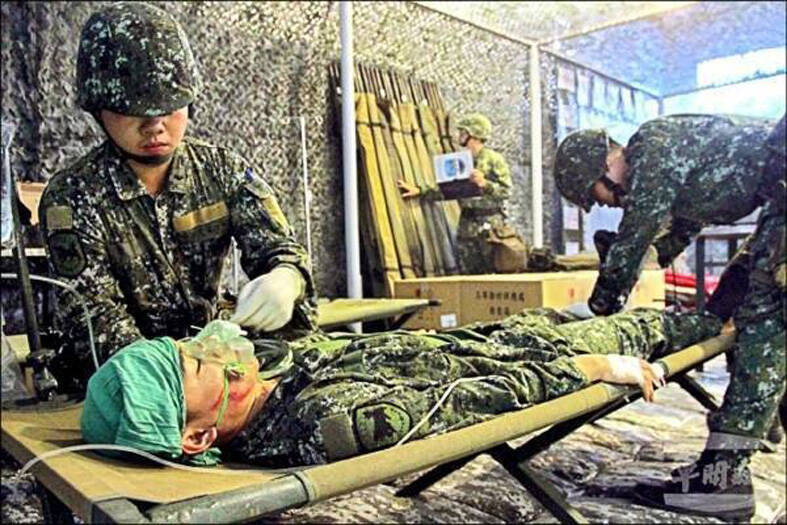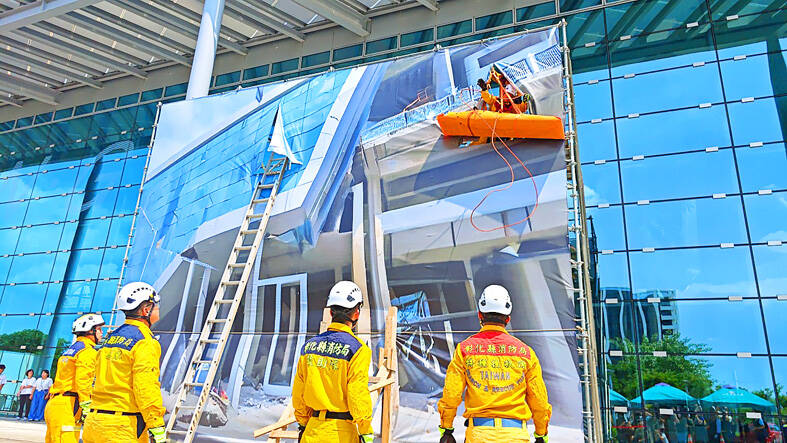The Ministry of National Defense (MND) yesterday detailed efforts to boost the nation’s wartime medical resilience, including a plan to set up a blood donation management unit.
Defense officials made the remarks in a report submitted to lawmakers ahead of Minister of National Defense Wellington Koo’s (顧立雄) question-and-answer session at the legislature’s Foreign Affairs and National Defense Committee today.
The ministry said it had made efforts to enhance the military’s stockpiles, equipment repair and maintenance, digital communications, and battlefield medicine capabilities.

Photo courtesy of the 8th Army Corps
The armed forces have also enhanced its communications with the Ministry of Health and Welfare, the National Fire Agency, county-level public health agencies and hospitals to create a wartime health system, it said.
The military last year conducted seven joint exercises with the civil government and private hospitals, and plans to hold seven more this year, it said.
The planned exercises would focus on certifying hospitals’ ability to stabilize the injured before their transfer to military care and send surgical units to the outlying islands, it said.

Photo: Chen Kuan-pei, Taipei Times
The armed forces by December would found a national blood donation unit, the first organization of its kind, and establish blood banks at hospitals in central, southern and eastern Taiwan, it said.
The MND said next year it would launch the tri-service blood program, a centralized blood supply system to standardize blood policy and operating procedures to secure blood supplies in wartime.
It said it bolstered medical services’ chemical, biological, radiological and nuclear warfare capabilities by certifying military hospitals in Kaohsiung and Hualien.
Military medical services would be able to provide basic care in case of chemical, biological or nuclear attacks anywhere in Taiwan, it said.
The MND and the Ministry of Health and Welfare in 2023 established a reserve capacity that could be activated to provide medical care to wounded military personnel and civilians during an armed conflict, it said.
Officials are creating mobilization plans for nurses and caregivers to deal with non-critically injured civilians at first aid stations across 300 townships, it said.
In other news, the Presidential Office’s Whole-of-Society Defense Resilience Committee said it is on Thursday next week to hold its first-ever field exercise in Tainan.
The exercise would test Taiwan’s capability to respond to a natural disaster that could severely damaging its infrastructure, such as an earthquake and tsunami, it said.
Cabinet officials, the Tainan City Government and the Presidential Office would participate in the exercise, it said.
The committee said its mission is to implement the policy of President William Lai’s administration to strengthen the nation’s resilience against threats posed by natural disasters and authoritarian expansionism.
Improving the coordination between central and local governments, and the private and public sectors is key to make Taiwan’s national defense, civil society, natural disaster response and democracy resilient, it said.
The committee said it would convene its third meeting and hold a news conference in Tainan after the exercise.
The exercise would feature simulations to evacuate people, provide shelter, and establish field hospitals and aid stations, Presidential Office spokeswoman Karen Kuo (郭雅慧) said.
The exercise would have components A and B, which would be conducted at Tainan’s Nanning High School and in front of Anping Harbor tourist information center, she said.

The US government has signed defense cooperation agreements with Japan and the Philippines to boost the deterrence capabilities of countries in the first island chain, a report by the National Security Bureau (NSB) showed. The main countries on the first island chain include the two nations and Taiwan. The bureau is to present the report at a meeting of the legislature’s Foreign Affairs and National Defense Committee tomorrow. The US military has deployed Typhon missile systems to Japan’s Yamaguchi Prefecture and Zambales province in the Philippines during their joint military exercises. It has also installed NMESIS anti-ship systems in Japan’s Okinawa

TRAGEDY STRIKES TAIPEI: The suspect died after falling off a building after he threw smoke grenades into Taipei Main Station and went on a killing spree in Zhongshan A 27-year-old suspect allegedly threw smoke grenades in Taipei Main Station and then proceeded to Zhongshan MRT Station in a random killing spree that resulted in the death of the suspect and two other civilians, and seven injured, including one in critical condition, as of press time last night. The suspect, identified as a man surnamed Chang Wen (張文), allegedly began the attack at Taipei Main Station, the Taipei Fire Department said, adding that it received a report at 5:24pm that smoke grenades had been thrown in the station. One man in his 50s was rushed to hospital after a cardiac arrest

‘WIN-WIN’: The Philippines, and central and eastern European countries are important potential drone cooperation partners, Minister of Foreign Affairs Lin Chia-lung said Minister of Foreign Affairs Lin Chia-lung (林佳龍) in an interview published yesterday confirmed that there are joint ventures between Taiwan and Poland in the drone industry. Lin made the remark in an exclusive interview with the Chinese-language Liberty Times (the Taipei Times’ sister paper). The government-backed Taiwan Excellence Drone International Business Opportunities Alliance and the Polish Chamber of Unmanned Systems on Wednesday last week signed a memorandum of understanding in Poland to develop a “non-China” supply chain for drones and work together on key technologies. Asked if Taiwan prioritized Poland among central and eastern European countries in drone collaboration, Lin

ON ALERT: Taiwan’s partners would issue warnings if China attempted to use Interpol to target Taiwanese, and the global body has mechanisms to prevent it, an official said China has stationed two to four people specializing in Taiwan affairs at its embassies in several democratic countries to monitor and harass Taiwanese, actions that the host nations would not tolerate, National Security Bureau (NSB) Director-General Tsai Ming-yen (蔡明彥) said yesterday. Tsai made the comments at a meeting of the legislature’s Foreign Affairs and National Defense Committee, which asked him and Minister of National Defense Wellington Koo (顧立雄) to report on potential conflicts in the Taiwan Strait and military preparedness. Democratic Progressive Party (DPP) Legislator Michelle Lin (林楚茵) expressed concern that Beijing has posted personnel from China’s Taiwan Affairs Office to its